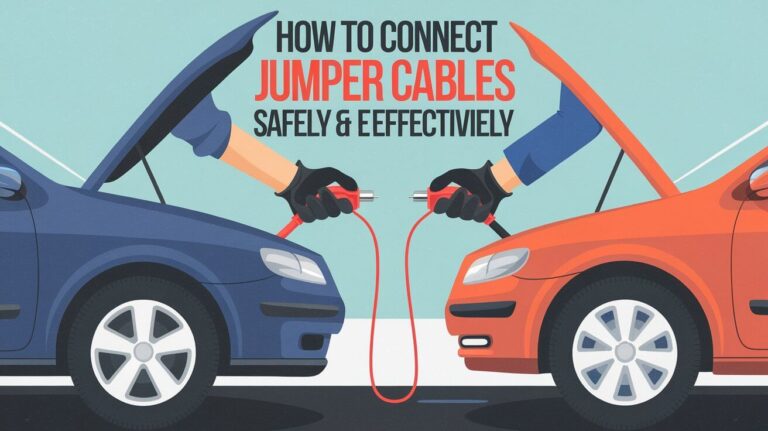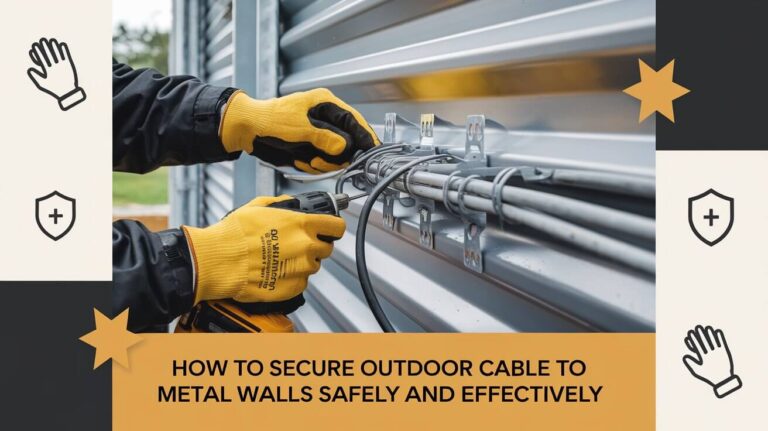How to Use Jumper Cables Safely: Step-by-Step Guide & Tips

A dead car battery can turn any day upside down, but knowing how to use jumper cables can get you back on the road quickly. This guide will explain everything you need to safely and effectively jump-start your car. From understanding the basics of jumper cables to step-by-step instructions, you’ll find all the information you need below.
What You Need Before Jump Starting a Car
Jumper Cables Specifications
Choosing the right jumper cables is crucial for safety and effectiveness. Here are some tips on selecting the proper cables:
- Cable Gauge: The thickness of the cable, or its gauge, impacts how well it can transfer power. A lower number indicates a thicker wire, with 8-gauge or thicker recommended for most vehicles.
- Length: Jumper cables should be at least 10–20 feet long to reach comfortably between vehicles.
- Clamp Quality: Choose well-insulated, corrosion-free clamps. They should have a firm grip on the battery terminals to ensure a secure connection.
Essential Equipment
Before you start, make sure you have the following:
- A set of jumper cables.
- A functioning car with a fully charged battery.
- Protective gloves and safety glasses to prevent injury.
- Optionally, you may consider a portable jump starter as an alternative for emergencies.
Safety Precautions
Safety should always be a priority. Here’s what to keep in mind:
- Never jump-start a car in a closed area. Carbon monoxide from a running engine can be deadly.
- Ensure both vehicles are turned off and the parking brakes are engaged.
- Avoid using cables with visible damage or corrosion.
- If the battery is visibly damaged, leaking, or cracked, do not attempt to jump-start. Seek professional help.
Understanding Battery Terminals and Cable Color Coding
To use jumper cables correctly, it’s essential to understand battery terminals:
- The positive terminal is usually marked with a “+” symbol and is often covered with a red cap.
- The negative terminal has a “–” sign and is usually covered with a black cap.
- Match the clamp colors to the terminal signs: red clamp for the positive terminal and black clamp for the negative or grounding point.
Step-by-Step Guide: How to Use Jumper Cables
Preparation
- Position the vehicles: Park the functioning car close to the vehicle with the dead battery, but ensure they are not touching. The engines should face each other if possible.
- Turn off the engines: Engage the parking brakes and switch off all electronic devices (lights, radio) in both cars.
Locate the Batteries
- Open the hoods of both vehicles and locate the battery terminals. If you’re unsure, consult the vehicle’s manual to identify the exact location.
Connecting the Jumper Cables
Follow these steps carefully:
- Red Clamp to Dead Battery’s Positive Terminal: Attach one red clamp to the positive terminal on the dead battery.
- Red Clamp to Donor Battery’s Positive Terminal: Connect the other red clamp to the positive terminal of the charged battery.
- Black Clamp to Donor Battery’s Negative Terminal: Attach one black clamp to the negative terminal of the working battery.
- Black Clamp to an Unpainted Metal Surface on the Dead Car: Instead of connecting the last black clamp to the dead battery’s negative terminal, find a metal part away from the battery, such as a bolt or engine block. This acts as a grounding point to avoid sparks.
Starting the Cars
- Start the donor car: Turn on the vehicle with the charged battery and let it idle for 3–5 minutes.
- Attempt to start the dead car: Try starting the car with the dead battery. If it doesn’t start, wait a few more minutes.
- If the car still won’t start, ensure all connections are secure and let the donor car run a little longer.
Disconnecting the Jumper Cables Safely
Once the dead car starts, carefully remove the cables in reverse order:
- Remove the black clamp from the grounded surface on the dead car.
- Detach the black clamp from the negative terminal of the donor battery.
- Remove the red clamp from the donor car’s positive terminal.
- Detach the red clamp from the dead car’s positive terminal.
Running the Jumped Car
- Let the jumped car idle for 15–20 minutes to recharge the battery. This prevents it from stalling once turned off.
Safety Tips for Jump Starting a Car
Jumping a car’s battery involves high current, which can be dangerous if not handled properly:
- Avoid touching the metal clamps together when connected to the batteries to prevent sparks or electrical damage.
- Keep hands and clothing away from moving engine parts when the engine is running.
- Check for corrosion on battery terminals before attaching the clamps. Corroded terminals can prevent proper charging.
Common Mistakes to Avoid When Using Jumper Cables
- Incorrect Connections: Reversing the red and black clamps can cause short circuits, damage to the car’s electrical system, or battery explosions.
- Skipping the Ground Connection: Always connect the last black clamp to a metal grounding point instead of the battery’s negative terminal to reduce the risk of sparks.
- Using Damaged Cables: Inspect the cables for any visible wear, cracks, or corrosion before use.
How to Test the Battery’s Condition After Jump Start
After successfully jump-starting your car, it’s essential to check the battery’s condition:
- Monitor the car’s performance: If it starts hesitating or doesn’t hold a charge, you may need a replacement battery.
- Use a multimeter to check the battery voltage. A fully charged battery should read around 12.6 volts or higher when the car is off.
- Consider visiting a mechanic for a battery load test, which can give a more accurate assessment.
Troubleshooting Tips If the Car Doesn’t Start
Sometimes, the jump start might not work on the first try. Here’s what to do:
- Check the cable connections: Make sure they are firmly attached to clean, corrosion-free terminals.
- Wait longer: Leave the donor car running for a few more minutes to allow additional charging.
- If multiple attempts fail, there might be a deeper issue like a faulty starter, alternator, or bad battery.
Additional Tips for Battery Maintenance
Prevent future battery issues with these tips:
- Turn off all lights and electronics when the engine is off to avoid draining the battery.
- Regularly inspect your battery for signs of wear or corrosion. Clean the terminals if needed.
- Consider purchasing a portable battery charger as a backup in case of emergencies.
FAQ: Common Questions About Using Jumper Cables
What if the Car Still Doesn’t Start After Using Jumper Cables?
- Double-check the connections, and ensure the clamps are making good contact with the metal. If it still doesn’t start, it might be a sign of a deeper electrical issue.
How Long Should I Leave the Cables Connected?
- Typically, the cables should be connected for about 5–10 minutes, depending on how drained the battery is. Let the donor car idle for a while to build up charge.
Can I Use Jumper Cables on Hybrid or Electric Vehicles?
- Many hybrids can be jump-started, but it’s best to refer to the vehicle’s manual. Fully electric vehicles may have different requirements.
Why Connect the Black Clamp to a Grounding Point Instead of the Battery?
- Attaching the last connection to a grounding point minimizes the risk of igniting hydrogen gas, which may be emitted by the battery.
Related Topics
How Do Car Batteries Work?
Understanding the basics of how car batteries function can help in diagnosing why they fail. Car batteries store chemical energy and convert it into electrical energy, which is crucial for starting the car.
Alternatives to Using Jumper Cables
Portable jump starters are a convenient alternative. They allow you to jump-start a car without needing another vehicle, and many are compact and easy to store.
How to Choose Quality Jumper Cables
Invest in cables with thicker wires (lower gauge), well-insulated clamps, and a reliable brand. They will last longer and perform better under stress.
Common Causes of a Drained Battery
Car batteries can die due to various reasons, such as leaving lights on, cold weather, short trips that don’t allow full charging, or old age. Identifying the cause can help prevent future issues.
Conclusion
Knowing how to use jumper cables is an essential skill for any driver. With the right equipment and careful handling, you can safely jump-start a car and be on your way. Remember to regularly maintain your car’s battery, invest in quality jumper cables, and follow safety guidelines to avoid common pitfalls.
By mastering this simple yet vital process, you’ll be prepared to handle unexpected battery failures without stress.




